This paper examines a shortfall in US Army doctrine. Specifically during the Course of Action (COA) Analysis step in the Military Decision Making Process (MDMP), there is currently no useful discussion and no examples of COA Analysis (“wargaming”) during other than major combat operations at the tactical level in any of the US Army’s doctrinal publications. The author looks at what is currently written in doctrine and then provides a review of the literature and offers some ideas for helping staffs wargame and assess critical events in these types of operations.
Currently there are no examples that explain how to conduct Course of Action (COA) Analysis (commonly called “wargaming”) at the tactical level during other than major combat operations (irregular warfare, stability operations, or counterinsurgency) in any of the relevant US Army doctrinal manuals (ATTP 5-0.1, FMs 3-07, 3-24, or 3-24.2). This paper examines the most difficult steps in the wargaming process and offers some ideas and examples to help the wargaming process.
The doctrinal steps of the wargaming process are: (ATTP 5-0.1 p. 4-23)
- Step 1. Gather the tools
- Step 2. List all friendly forces
- Step 3. List assumptions
- Step 4. List known critical events and decision points
- Step 5. Select the war-gaming method
- Step 6. Select a technique to record and display results
- Step 7. Wargame the operation and assess the results
- Step 8. Conduct the wargame briefing. (optional)
As a Department of Army Tactics Instructor at the US Army’s Command and General Staff College (CGSC), it has been my experience after 17 years of teaching that students (and instructors) routinely wrestle with four of the doctrinal steps when it comes to conducting Course of Action Analysis. These are:
- Step 4. List known critical events and decision points
- Step 5. Select the war-gaming method
- Step 6. Select a technique to record and display results
- Step 7. Wargame the operation and assess the results
REVIEW OF CURRENT LITERATURE
ATTP 5-0.1, Commander and Staff Officer Guide, Chapter 4 has 13 pages of doctrinal step-by-step explanation of the general wargaming process along with eight “figure” examples. Three of the eight are used as to portray the various wargaming methods (modified belt, avenue-in-depth, and box) that are focused on stability operations. The remaining figures are used to show the methods for major combat operations. It does include two examples of techniques for recording and displaying results, however both of these have a major combat operations focus.
FMs 3-07, Stability Operations, and 3-24, Counterinsurgency, contain no references or examples of COA Analysis.
FM 3-24.2 Tactics in Counterinsurgency, Chapter 4 does contain approximately three pages of text along with an example of a blank synchronization matrix. The text does elaborate in some detail the eight steps of COA Analysis in a counterinsurgency (COIN) environment using an approach they title Modeling. It provides some good detail about the considerations and steps to laying out a wargame process for the staff in a COIN environment. It suggests applications such as using the Lines of Effort (LOE) as the basis for critical events and decision points. It also suggests some staff techniques and procedures (eg, visual board and staff roles) for conducting and recording the analysis, but offers no practical examples. This chapter along with the doctrinal reading from ATTP 5-0.1 Chapter 4, offer the most relevant readings.
(There are no discussions of the wargaming process in ADP 5-0, The Operations Process, or ADRP 5-0.)
THE FOUR PROBLEM AREAS.
Step 4. List Known Critical Events and Decision Points.
CGSC students usually do learn and perform the doctrinal steps of COA analysis but wrestle with the specifics of “how to”? They can normally figure out these problem steps for major combat operations (offense and defense) scenarios such as identifying critical events and decision points, selecting appropriate methods, recording and displaying results, but struggle trying to do so in stability operations, irregular warfare, and COIN environments.
Example #1. Irregular warfare scenario:
1/25 SBCT Secures MSR X-Ray (the Ganja Highway) ahead of the 4th Infantry Division’s move down the main supply route (MSR) into their new Area of Operation. The student developed COA usually describes the SBCT’s tactical movement down the route to occupy and control key terrain along the division’s MSR. When asked to identify critical events and decision points for analysis they normally pick events that amount to subordinate unit battle drills (react to an IED or ambush) and rarely identify anything that would be considered a “BCT level critical event.” The results of their analysis normally show time and fuel requirements to get the SBCT into position to secure the critical points along the MSR and some of the “synchronization” (coordination and task organization) requirements that will be necessary. They seldom identify likely BCT commander decisions or branches.
Example #2. Post major combat operations (Phase IV) scenario:
3/4 ABCT occupies Bilesuvar Rayon immediately following major combat operations (Stability Operations environment). The student COA usually describes the ABCT’s movement from Ganja into the Bilesuvar Rayon and which subordinate battalions will occupy which districts. The students normally describe the “troop-to-task” requirements for the ABCT and make recommendations to the task organization and submit a Request For Forces (RFF). When asked to identify critical events and decision points for analysis they normally pick events that describe the initial occupation of the subordinate battalion AOs. Some groups do identify various LOE and create likely critical events that could occur and use those to wargame, however that is usually a result of the instructor’s prompting.
In an environment such as the first scenario (Secure MSR X-RAY) where critical events and decisions points are not obvious, nor are there any established Lines of Effort (LOE) at this point, it begs the question: “What constitutes a critical event or decision point?” One team of students when asked to answer this problem concluded that COA analysis amounts to analyzing critical decisions facing a commander and staff. In the absence of obvious critical events or decisions points they developed a list of “most likely (and plausible) events” that would cause the BCT commander to have to make a decision in regards to five areas; enemy, terrain, friendly, civilians, and the employment of reserve forces. They developed a list that was reviewed and reworded in order to ensure that the event(s) would force a decision up to the BCT commander and staff for action. The group referred to this technique as the “5 event wargame.” Figure 1 below is the list of critical events the students developed:
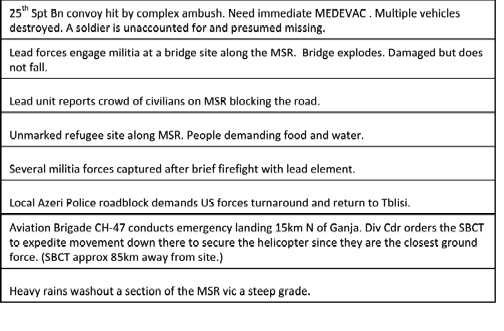
Figure 1
These events forced several things: 1) Whether or not it is actually a BCT commander level decision (or is it an SOP action)?, 2) a detailed look at their task organization, 3) an appreciation of time and distance factors, 4) a more detailed look at the terrain and infrastructure, 5) Warfighting Functions (WFF) synchronization requirements and 6) refined Commander’s Critical Information Requirements (CCIR) and contingency planning instructions.
When the students got to this phase and began planning for the second scenario (Phase IV post combat operations) in the Bilesuvar Rayon, they concluded that a similar approach using the “5 event wargame” technique helped identify critical events and decisions points (see Figure 2).
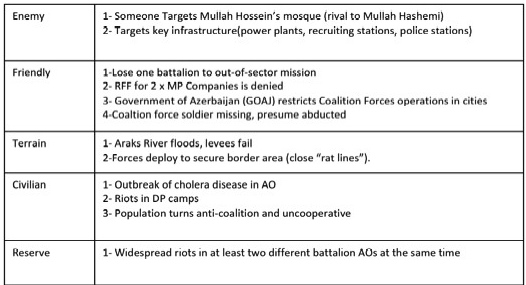
Figure 2
Another group used the Lines of Effort (LOE) they developed to identify critical events and decisions points for the second scenario (see Figure 3). Both techniques resulted in the identification of critical events and decisions points.
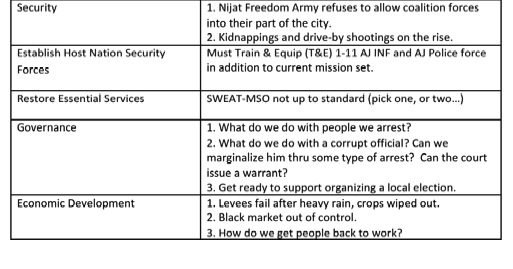
Figure 3
The “5 event wargame” (Figure 2) seemed to work best in the Irregular Warfare environment when the threat was elusive and vague at best. The “LOE framework” (Figure 3) seemed to work best for the Stability Operations environment mainly due to the level of specified information developed during mission analysis (MA) and COA development.
One of the products of MA and COA development was the LOE chart based on the example from FM 3-24.2, Chapter 4 (see Figure 4). Using this method, there was never a shortage of critical events or decision points to analyze. The challenge was making it relevant to the BCT Commander and staff.
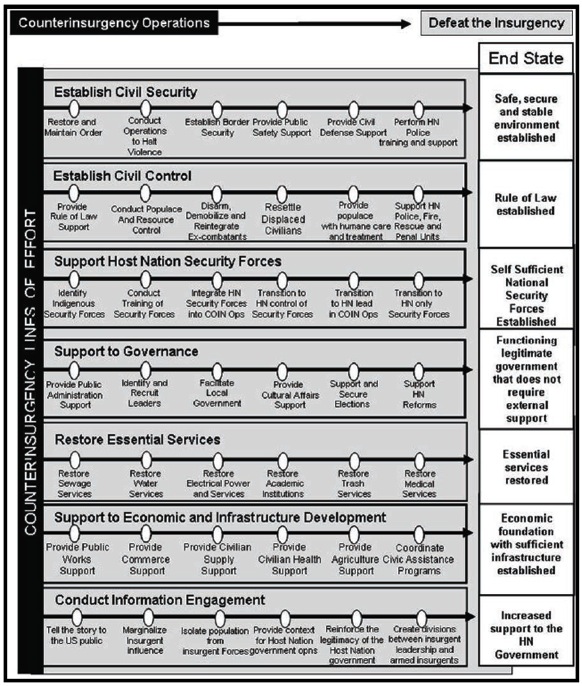
Figure 4
Identifying critical events in the Counterinsurgency (COIN) environment were not addressed in any of the manuals. It seems logical that since a counterinsurgency would probably exist in an area with some form of existing government, infrastructure, and known population sets, that the framework used for stability operations (some type of LOE) would make a logical framework for developing critical events and decision points in a COIN environment.
Step 5. Select the War-gaming Method.
ATTP 5-0.1, Chapter 4, lists the three types of wargaming methods (belt, avenue-in-depth, box method) and a brief description of each. A modified box method is usually the most logical method because most of the events that you analyze are normally geographically isolated to a small area (see Figures 5 and 6). There are applications to the other methods such as the avenue-in-depth when the critical event is something such as focusing on a single line of effort from start to finish, whereas a belt method might be appropriate for simultaneous operations across an entire district, such as by a BCT or Division Headquarters.
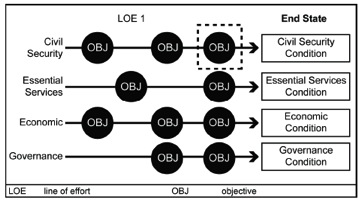
Figure 5
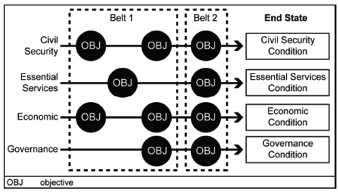
Figure 6
Step 6. Select a technique to record and display results.
Next is the means to record and display the results of the wargame. ATTP 5-0.1, Chapter 4, list two methods: the synchronization matrix, and the sketch note method. Both are shown as illustrations and display information in their blanks that are associated with a major combat operation (division and BCT deliberate attack – see Figures 7 and 8).
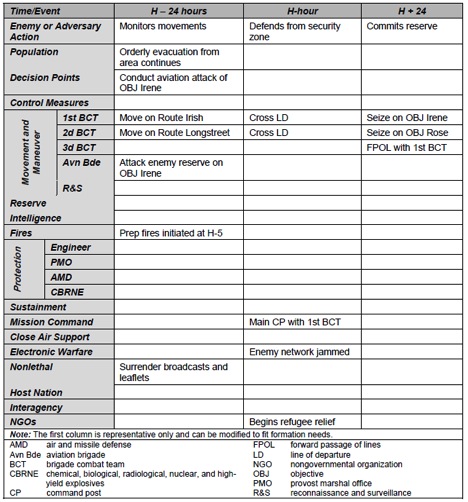
Figure 7
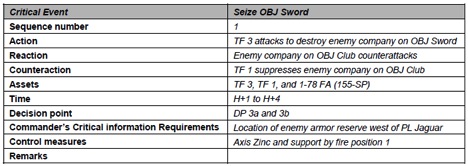
Figure 8
The text in chapter 4 does a sufficient job of explaining what the purpose is of each and how they can be used to synchronize the WFF requirements for the operation. Either method has application for the non-MCO environments and boils down to a personal preference. FM 3-24.2, Chapter 4 shows a blank synchronization matrix (see Figure 9). While this example might help frame the environment, it offers no suggestions of what goes in any of the blanks.
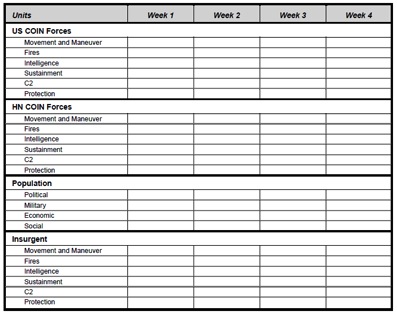
Figure 9
Step 7.Wargame the Battle and Assess the Results.
The first example from ATTP 5-0.1 (Figure 6) shows a time based sequence rather than listing out “critical events” for the division. The pitfall with a time based activity is just that – actions should be event driven in regard to one another, as opposed to time driven. It makes more sense for the activity at the top of the first event column to be labeled as “Approach thru the Enemy Security Zone” followed by “Penetrate the Enemy MBA”, followed by “Seize OBJs IRENE and ROSE.” Once the specific critical events are identified, the synchronization requirements and decision point(s) should become apparent and the information in the boxes should become easy to determine.
Figure 8 is from FM 3-24.2, Chapter 4. It shows a blank synchronization matrix with a brief description of the wargaming activities conducted during this step but does not show any examples of what might go in any of the boxes like figures 7 and 8 shows from ATTP 5-0.1. Like figure 7, this one also shows the columns listed as time frame based (a week at a time), rather than being event based. While this might be appropriate for helping to allocate forces at the operational level, it does not lend itself to helping the tactical unit commanders (specifically BCT and below).
Nowhere in our doctrine are there examples of what would constitute a critical event or decisions points in these type environments.
Another idea.
One student group developed their own wargaming matrix that captured their analysis in Figure 10 below. Their particular matrix was laid out horizontally using five columns. The “critical event” was the first entry. The five columns are laid out accordingly left to right:
“IF” represents the “action” (the critical event to be wargamed) normally initiated by another group (militia, civilians, etc…).
“AND” represents what should be the expected protocol for that case, but for some reason has failed, thereby forcing a decision upon the command.
“THEN” represents the friendly reaction (or decision). This is where the command begins to integrate the various warfighting functions.
“SO WHAT?” represents the results of this process (the actual analysis). This includes the likely counteractions of the key leaders / populations, along with instructions to subordinate units as well as determining possible preemptive measures.
 Figure 10
Figure 10
Having used the “5 event wargame” as a means to identify their critical events, they laid them out in the first column of this matrix and then filled in the blanks from left to right. This matrix allowed the group to work thru a detailed analysis of critical events, identify decision points, and make an assessment of likely actions and reactions using a box-method format. Their analysis included several options for the command and suggested some preemptive measures to possibly negate the critical event from ever occurring. When their group executed their plan during the practical exercise phase they were better prepared than all their predecessor groups. The group did encounter some of the exact events they had wargamed, but also encountered many they had not. However, with the matrix from figure 10 as their “mental model” they were quickly able to think thru the events and develop satisfactory actions to counter them.
Summary
COA Analysis is a difficult and time consuming skill to teach. The keys to teaching it effectively is understanding exactly what are the critical events to be wargamed, and how to lay them out in a manner that makes sense to the command so that resources can be applied against them. The ideas in this paper offer some suggestions on helping staffs to think thru how to make sense of these complex problems and how to counter them in non-MCO environments. The very nature of irregular warfare, stability operations, and counterinsurgencies make them hard to predict the most likely action and reactions. However, developing some type of mental models like the ones offered in this article, we can better think thru likely and plausible critical events, and develop appropriate actions and or reactions.
About the Author(s)
Comments
I wonder how the students approach "Step 4. List known critical events and decision points"? In the examples it seems there is a series of tailor-made options (e.g. corrupt official, power-plant failure, flood). It's not entirely clear where these events come from. If they are scripted in the scenarios, do the scenarios give legitimate outcomes if the event is handled well or poorly?
Also, figure 10 gives the impression that the "If", "And", and "So What?" columns come from a menu of cause/effects rather than being arrived at by some analytical process or event-driven point in time during the game.
This impression leads to a sense of artificiality in the whole game.
